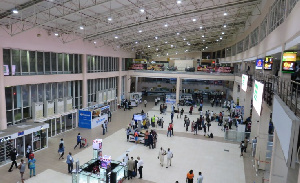Opinions of Saturday, 30 May 2020
Columnist: Mark Ofosu
Towards the new normal: IATA, ACI lead the way
The Health Minister of Ghana, Kwaku Agyeman Manu during one of the Ministry of Information’s press briefing on coronavirus indicated that the novel Coronavirus needed to be treated as one that has come to live with us just like any other disease and therefore we cannot run from it but face reality and adopt pragmatic measures to help us cope.
Though many disagreed with the Minister on his assertion, somewhere on the global scene towards the creation of the new normal in the aviation industry, the International Air Transport Association (IATA) seems to have constructed a new world for passengers’ on how movement by air should be.
In leaving up to its name as the global trade association of some 290 airlines across the world representing 82% of global air traffic IATA, together with the Airports Council International (ACI), the trade organization of world airports has released a paper stipulating the measures airports, governments, airlines and other stakeholders in the aviation industry must adhere to for a safe resumption of air transport.
It is important to note that the fundamental value held by IATA and ACI for the introduction of the new road map is to ensure that air transport does not become the means of coronavirus transmission.
Towards the new normal the following are descriptions of what travelling by air would look like should travel restrictions be eased across borders for resumption of commercial flights:
Now, after an individual makes a booking, before embarking on any journey, adequate contact information will now be required to help assist in contact tracing should the need arise.
At the airports, though subject to airports specifications, persons who have no essential business at the airports are not encouraged to be there. (So in our case should the Ghana Airports Company adopt this, it could be said that the norm where a whole family troop to the airport to see a relative off will have to be reduced). Again, practice of social distancing will be expected to be seen at airports, cleaning and disinfection, wearing of Personal Protective Equipment (airport staff and passengers), baggage dropping will be done by passengers other than check-in agents. For Check-in, all relevant information required from passengers will be expected to be completed while the printing of boarding passes and baggage tags from home will be the norm.
During the boarding process, airports will now provide a new order for the boarding of aircrafts and also while onboard face masks will be required in situations where physical distancing (blocking of some seats) is not possible. Again, meals will now be served in “take-away” style with the provision of sanitary wipes for cleansing of surfaces.
Upon arrival at destination airports, the process of declaration at custom points would now be more of electronic in nature and a decrease in time for baggage collection should be expected. In the case of passenger transfers, the ‘transiting airports may rely on the initial screening process done by the airport of the passengers’ origin unless otherwise.
In all this, aside the thermal screening of passengers, so far, there is no compulsory testing of passengers required for the boarding of aircrafts unless an airport has a proven efficient method and capacity in testing people in a manner that will not create congestion at the airport.
Towards the new normal, IATA and ACI’s roadmap certainly is one that seeks to put countries on the part of economic recovery and also promote safety while travelling by air. These measures, for now, seem to be making some positive strides among airlines that have resumed operations across the globe so far, however, the general sense of it I believe is to stimulate the interest of the travelling public for air transport once again.
Entertainment










